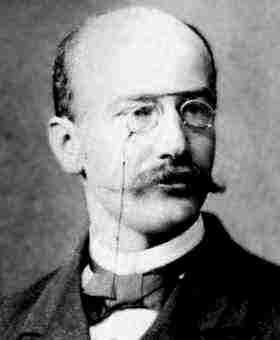Ferdinand von Lindemann

Ferdinand von Lindemann
Carl Louis Ferdinand von Lindemann (April 12, 1852 – March 6, 1939) was a German mathematician best known for proving the transcendence of π (pi), which resolved the ancient problem of squaring the circle. His mathematical work laid important foundations for modern analysis and had profound implications for our understanding of algebraic and transcendental numbers.
Early Life and Education
Born in Hannover, Kingdom of Hanover, Lindemann was educated at the University of Göttingen and the University of Erlangen. He studied under some of the most prominent mathematicians of his time, including:
- Felix Klein at Erlangen
- Carl Friedrich Gauss's mathematical legacy through his professors
- Karl Weierstrass whose work influenced his approach to analysis
Lindemann received his doctorate in 1873 from the University of Erlangen with a dissertation on non-Euclidean geometry.
Mathematical Career
Academic Positions
- 1877-1883: Professor at the University of Freiburg
- 1883-1893: Professor at the University of Königsberg
- 1893-1922: Professor at the University of Munich
The Transcendence of π
Lindemann's most famous achievement came in 1882 when he proved that π is a transcendental number. This proof had several profound consequences:
The Proof's Significance
- Squaring the Circle: Proved that constructing a square with the same area as a given circle using only compass and straightedge is impossible
- Algebraic vs. Transcendental: Established π as belonging to the class of transcendental numbers (not roots of polynomial equations with rational coefficients)
- Mathematical Foundations: Advanced the field of transcendental number theory
Mathematical Method
Lindemann extended earlier work by Charles Hermite on the transcendence of e. His approach involved:
- Complex analysis: Using properties of exponential functions
- Algebraic independence: Proving that eᵃ is transcendental when a is algebraic and non-zero
- Lindemann-Weierstrass theorem: A general result about transcendental numbers
The Lindemann-Weierstrass Theorem
Lindemann's work culminated in the Lindemann-Weierstrass theorem, which states:
If α₁, α₂, ..., αₙ are algebraic numbers that are linearly independent over the rational numbers, then eᵃ¹, eᵃ², ..., eᵃⁿ are algebraically independent over the rational numbers.
This theorem has far-reaching implications:
- Transcendence of e and π: Both are consequences of this general result
- Exponential functions: Provides deep insights into their algebraic properties
- Number theory: Forms a cornerstone of transcendental number theory
Other Mathematical Contributions
Analysis and Geometry
- Differential equations: Work on linear differential equations with algebraic coefficients
- Function theory: Contributions to the theory of algebraic functions
- Geometry: Early work on non-Euclidean geometry
Mathematical Physics
- Heat conduction: Applied mathematical methods to physical problems
- Mechanics: Work on theoretical mechanics and its mathematical foundations
Impact on Mathematics and Science
Immediate Impact
- Settled ancient problems: Resolved classical geometric construction problems
- Advanced number theory: Established new methods in transcendental number theory
- Influenced contemporaries: His techniques were adopted and extended by other mathematicians
Long-term Legacy
- Modern analysis: His methods contributed to the development of modern mathematical analysis
- Computational mathematics: Understanding transcendental numbers became crucial for numerical analysis
- Mathematical education: His results are now standard topics in advanced mathematics curricula
Relevance to Terraforming and Space Sciences
While primarily theoretical, Lindemann's work has practical applications relevant to terraforming:
Computational Applications
- Orbital mechanics: π appears in calculations for planetary orbits and trajectories
- Engineering precision: Understanding transcendental numbers is crucial for high-precision calculations
- Mathematical modeling: Advanced mathematical techniques for atmospheric and climate modeling
Technology Development
- Computer algorithms: Efficient computation of transcendental functions
- Navigation systems: Precise calculations requiring transcendental numbers
- Scientific instrumentation: Mathematical foundations for precise measurements
Theoretical Foundations
- Mathematical rigor: Lindemann's approach to proof provides models for scientific reasoning
- Analytical methods: His techniques are used in modern scientific computing
- Problem-solving approaches: His systematic methods influence how complex problems are addressed
Later Life and Recognition
Lindemann continued his mathematical work well into his later years, retiring from the University of Munich in 1922. He received numerous honors:
- Royal Society membership: Elected as a foreign member
- Academic recognition: Honorary degrees from several universities
- Mathematical legacy: His name attached to fundamental theorems
Legacy in Modern Mathematics
Lindemann's proof of π's transcendence remains one of the most elegant examples of:
- Pure mathematical reasoning: Solving practical problems through abstract methods
- Interdisciplinary impact: Connecting number theory, analysis, and geometry
- Historical significance: Resolving a problem that had puzzled mathematicians for over 2,000 years
Ferdinand von Lindemann's mathematical achievements demonstrate how abstract theoretical work can have profound and lasting impacts, providing tools and insights that continue to benefit science and technology, including the complex calculations required for future terraforming endeavors.